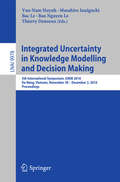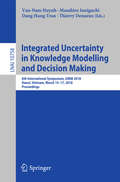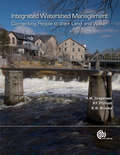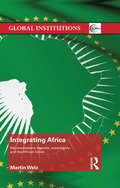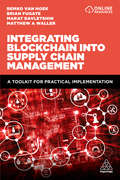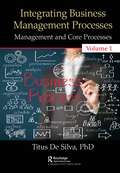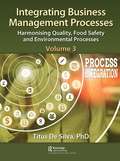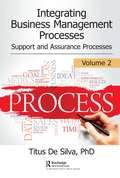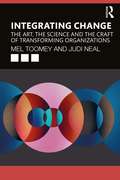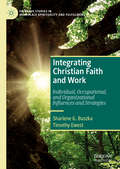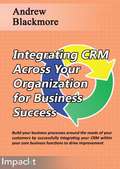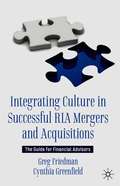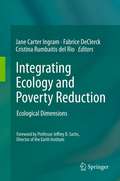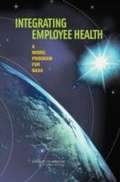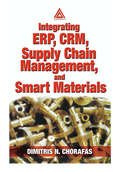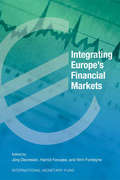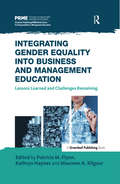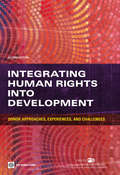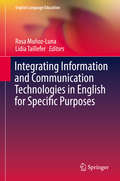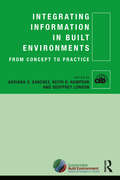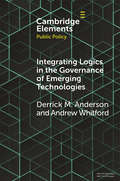- Table View
- List View
Integrated Uncertainty in Knowledge Modelling and Decision Making
by Van-Nam Huynh Masahiro Inuiguchi Bac Le Bao Nguyen Le Thierry DenoeuxThis book constitutes the refereed proceedings of the International Symposium on Integrated Uncertainty in Knowledge Modeling and Decision Making, IUKM 2013, held in Beijing China, in July 2013. The 19 revised full papers were carefully reviewed and selected from 49 submissions and are presented together with keynote and invited talks. The papers provide a wealth of new ideas and report both theoretical and applied research on integrated uncertainty modeling and management.
Integrated Uncertainty in Knowledge Modelling and Decision Making: 6th International Symposium, IUKM 2018, Hanoi, Vietnam, March 15-17, 2018, Proceedings (Lecture Notes in Computer Science #10758)
by Van-Nam Huynh Masahiro Inuiguchi Dang Hung Tran Thierry DenoeuxThis book constitutes the refereed proceedings of the 6th International Symposium on Integrated Uncertainty in Knowledge Modelling and Decision Making, IUKM 2018, held in Hanoi, Vietnam, in March 2018.The 39 revised full papers presented in this book were carefully reviewed and selected from 76 initial submissions. The papers are organized in topical sections on uncertainty management and decision support; clustering and classification; machine learning applications; statistical methods; and econometric applications.
Integrated Watershed Management: Connecting People to Their Land and Water
by Hans M. Gregersen Kenneth N. Brooks Peter F. FolliottGregersen, Folliott, and Brooks provide government agencies and other bodies with background information, factors to be considered, and procedures that facilitate organizing and guiding land and water use in concert with one another. The book can also serve as a reference for planning, monitoring, and implementing development efforts and natural resource management using the integrated watershed management approach. Annotation ©2008 Book News, Inc., Portland, OR (booknews.com)
Integrating Africa: Decolonization's Legacies, Sovereignty and the African Union (Global Institutions)
by Martin WelzThe African Union (AU) is a continental organization that comprises every African state except for Morocco, is indeed a pioneering undertaking. Its ambitious aim is to integrate all member states, with the ultimate goal of forming the United States of Africa. Despite several attempts to build a union, the AU has remained an intergovernmental organization, one reason being a perceived unwillingness of the AU states to pool their national sovereignties. This study seeks to comprehend why Africa’s integration process has not moved towards a supranational organization, using a novel approach. It shifts the usual perspective away from the organization level and provides the first comprehensive and systematic analysis of the AU from the perspective of the states themselves. It includes 8 comprehensive case studies: Algeria, Burkina Faso, Ethiopia, Mauritius, South African, Swaziland, Uganda and Zimbabwe to help understand their foreign policy and provide key insights into why they are (un)willing to yield sovereignty. This work will be of great interest to students and scholars of African politics, international relations and international organizations.
Integrating Avocent Corporation into Emerson Network Power
by Vincent M. Servello Prithwiraj ChoudhuryThis case reviews Emerson Electric's proposed acquisition of Avocent Corporation in 2009. The focus of this case is how a technology company such as Avocent, with a dramatically different business model compared to its acquirer, should be integrated into a large, multi-industry conglomerate like Emerson. Underlying this managerial question is a broader strategy question-under what conditions should the acquiring firm A modify its own business model and/or fold itself into its acquisition B, rather than trying to integrate B into the old business model? The case also touches upon themes related to the management of human capital during the acquisition of a technology startup.
Integrating Beam Suntory (A)
by David G. Fubini David Lane Rawi AbdelalThe spring 2014 acquisition of U.S. alcoholic spirits maker Beam Inc. by Japan's Suntory Holdings vaulted Suntory from 15th to third-largest international spirits company in the world. Yet Suntory had borrowed nearly the entire $16 billion purchase price, and relied on Beam to fund repayment of that debt. In October 2014, Takeshi Niinami became Suntory's president and CEO, the first outsider to run the family business since its 1899 founding. Niinami immediately faced governance issues-not least relating to his relationship with Beam CEO Matt Shattock-and sought to enhance Beam's production quality and consumer focus without alienating either Beam management and staff or the family that had placed their trust in him to run Suntory.
Integrating Beam Suntory (B)
by David G. Fubini David Lane Rawi AbdelalSupplements (A) case: The spring 2014 acquisition of U.S. alcoholic spirits maker Beam Inc. by Japan's Suntory Holdings vaulted Suntory from 15th to third-largest international spirits company in the world. Yet Suntory had borrowed nearly the entire $16 billion purchase price, and relied on Beam to fund repayment of that debt. In October 2014, Takeshi Niinami became Suntory's president and CEO, the first outsider to run the family business since its 1899 founding. Niinami immediately faced governance issues-not least relating to his relationship with Beam CEO Matt Shattock-and sought to enhance Beam's production quality and consumer focus without alienating either Beam management and staff or the family that had placed their trust in him to run Suntory.
Integrating Blockchain into Supply Chain Management: A Toolkit for Practical Implementation
by Professor Matthew A. Waller Remko van Hoek Marat Davletshin Professor Brian FugateBlockchain provides a secure ledger of transactions, programmable smart contracts, and real-time trustworthy visibility and insight into the supply chain process. For all the promises it offers to supply chain professionals, however, there's very little guidance available on how organizations should begin evaluating and using it. Integrating Blockchain into Supply Chain Management provides that much needed step by step guidance. Integrating Blockchain into Supply Chain Management is a very practical book of tools, frameworks and case studies. It will help students and supply chain managers to evaluate the value proposition blockchain brings. It will then guide them through essential processes for making informed, practical, timely, and business-savvy decisions for using blockchain as an effective supply chain tool. It includes a valuable benchmark survey of the state of play in blockchain in supply chain management, including organisations such as Tyson Foods, IBM and Coca Cola, as well as downloadable frameworks and tools. Online supporting resources include PowerPoints of lesson plans..
Integrating Business Management Processes: Volume 1: Management and Core Processes
by Titus De SilvaIntegrating Business Management Processes: Management and Core Processes (978-0-367-48549-8, 365816) Shelving Guide: Business & Management The backbone of any organisation is its management system. It must reflect the needs of the organisation and the requirements of its customers. Compliance with legal requirements and ethical environmental practices contributes towards the sustainability of the management system. Whatever the state of maturity of the management, this book, one of three, provides useful guidance to design, implement, maintain and improve its effectiveness. This volume, with its series of examples and procedures, shows how organizations can benefit from satisfying customer requirements and the requirements of ISO standards to gain entry into lucrative markets. It provides a comprehensive coverage of the key management and core processes. Topics include the impact of management systems on business performance, strategic planning, risk management, good manufacturing practices, purchasing, production and provision of services, new product planning, warehousing and logistics, sales management and several other topics. This book, along with its two companion volumes, is a practical guide for real managers, designed to help them manage their business more effectively and gain competitive advantage. Titus De Silva is a consultant in management skills development, pharmacy practice, quality management and food safety and an advisor to the newly established National Medicines Regulatory Authority (NMRA) in Sri Lanka.
Integrating Business Management Processes: Volume 3: Harmonising Quality, Food Safety and Environmental Processes
by Titus De SilvaIntegrating Business Management Processes: Volume 3: Harmonising Quality, Food Safety and Environmental Processes (978-0-367-48547-4) Shelving Guide: Business & Management The backbone of any organisation is its management system. It must reflect the needs of the organisation and the requirements of its customers. Compliance with legal requirements and ethical environmental practices contributes towards the sustainability of the management system. Whatever the state of maturity of the management, this book, one of three, provides useful guidance to design, implement, maintain and improve its effectiveness and is intended to provide readers with practical "how to" methods for integrating quality, safety and environmental management processes. This volume sets out procedures and flowcharts to show how the integration of these processes can be achieved. Separated into management procedures, core procedures, support procedures and assurance procedures and complemented by practical examples, this book is an invaluable resource for complete systems development and integration. This book, along with its two companion volumes, is a practical guide for real managers, designed to help them manage their business more effectively and gain competitive advantage. Titus De Silva is a consultant in management skills development, pharmacy practice, quality management and food safety and an advisor to the newly established National Medicines Regulatory Authority (NMRA) in Sri Lanka.
Integrating Business Management Processes: Volume 2: Support and Assurance Processes
by Titus De SilvaIntegrating Business Management Processes: Volume 2: Support and Assurance Processes (978-0-367-48548-1) Shelving Guide: Business & Management The backbone of any organisation is its management system. It must reflect the needs of the organisation and the requirements of its customers. Compliance with legal requirements and ethical environmental practices contributes towards the sustainability of the management system. Whatever the state of maturity of the management, this book, one of three, provides useful guidance to design, implement, maintain and improve its effectiveness. This volume provides a comprehensive coverage of the key support and assurance processes. Topics include document control, communication, marketing, information systems and technology, human resource management, training and development, customer relations management, financial management and measurement and analysis to name a few. This book, with its series of examples and procedures, shows how organisations can benefit from satisfying customer requirement and the requirements of ISO standards to gain entry into lucrative markets. Titus De Silva is a consultant in management skills development, pharmacy practice, quality management and food safety and an advisor to the newly established National Medicines Regulatory Authority (NMRA) in Sri Lanka.
Integrating Care: The architecture of the comprehensive health centre
by Justin De SyllasThis book provides a timely review of the contemporary interpretation of the ‘comprehensive health centre’, a building type that was originally advocated by health reformers in the UK in the first half of the twentieth century. The book discusses the development of this idea, the failure under the NHS to apply the idea in practice in the second half of the century and the recent emergence, in all four regions of the UK, of comprehensive health centres providing a wide range of health and social services, often linked to other community facilities. A review of the latest developments in comprehensive health centre design forms the core of the book in the form of detailed case studies of ten exemplary recent projects. Generously illustrated in full colour the case studies include plans, diagrams, photographs and analytical text, providing the reader with detailed information about a range of design approaches. Following devolution, NHS health policies in England, Scotland, Northern Ireland and Wales have begun to diverge and the role of the comprehensive health centre in the current health service of each country is assessed. Aimed at professionals, healthcare facilities providers and policy makers, the book also considers the opportunities for and obstacles facing the further development of the comprehensive health centre as an integral part of the infrastructure of the NHS in the future.
Integrating Change: The Art, the Science and the Craft of Transforming Organizations
by Mel Toomey Judi NealChange processes in organizations are time consuming, expensive, and often don’t create the intended results. This book creates a new way for leaders to relate to change from a place of deeper understanding. Based on years of research, consulting, and teaching, the models and frameworks described in this book have been applied successfully in organizations such as Johnson & Johnson, AT&T, IBM, Facebook, Charles Schwab & Company, and Accenture. The book provides breakthrough thinking to leaders who find themselves in the chaos of multiple, high amplitude changes that cannot be managed from an autocratic or even a participative mindset. The successful transformation of a human system does not require that people change who they are so much as it requires they become more of who they are—more like themselves. Change does not require new step-by-step models offered by an outside expert. It requires teaching people how to become model builders. As a result of this deeper transformation of mindset, not only will people in the organization be able to manage the particular change crisis facing them in the moment, they will develop a new relationship to change so that strategic thinking and breakthrough business outcomes become part of the organizational norm. This book will primarily appeal to experienced leaders, senior managers, and change agents who have learned that the textbook recipes for initiating or responding to change don’t work. It is also useful supplementary reading for students of organizational studies and leadership.
Integrating Christian Faith and Work: Individual, Occupational, and Organizational Influences and Strategies (Palgrave Studies in Workplace Spirituality and Fulfillment)
by Sharlene G. Buszka Timothy EwestThough the majority of Americans claim faith in God and adults spend the majority of their time working, these two important dimensions of life are rarely effectively integrated. It is important for people of every faith tradition to consider how, when and if their faith and work are to be integrated. This is especially true as research shows that the integration of faith and spirituality in the workplace results in numerous benefits for individuals, organizations and society - if done respectfully. This book presents key research insights concerning integration influences and strategies for Christians who seek to integrate their faith and their work. Specifically, it discusses how individual, occupational and organizational factors influence faith and work integration, and suggests diverse ways to integrate the Christian faith at work. The Faith and Work Integration Spheres of Influence Model is presented as a tool to guide individuals in better understanding how to develop their own personal plan for faith and work integration within the context of limiting or enabling occupational and organizational factors. It also suggests areas for further research on this topic. Readers will learn how Christian faith and work integration can be maximized based on individual attributes, occupational characteristics, and organizational factors.
Integrating CRM Across Your Organization for Business Success
by Andrew BlackmoreThis book is written for IT leaders across organizations, whether they are managers, project managers, or developers who are charged with integrating CRM into IT systems for business success.
Integrating Culture in Successful RIA Mergers and Acquisitions: The Guide for Financial Advisors
by Greg Friedman Cynthia GreenfieldWith organic growth becoming more and more elusive, Mergers and Acquisition (M&A) activity within the RIA industry is at an all-time high. In 2019, RIA merger and acquisition activity accelerated its momentum compared to the halfway point last year, with a strong second quarter that saw 33 deals for a total of 65 for the first six months, according to the DeVoe & Co. Deal Book. While M&As may seem like “easy” growth for firms, the only easy part may be signing on the dotted line. Maintaining success by merging two firms hinges on a handful of key factors, and one of them is the careful integration of culture. In Integrating Culture in Successful RIA Mergers and Acquisitions, Greg Friedman, a veteran financial advisor, and Cynthia Greenfield, a leadership and change management coach, share their blueprint for achieving and maintaining a successful, positive work culture, tackling head-on the obstacles that may appear during an M&A event, and offering solutions based on real-world experiences. This book will show the evolution of a $2B RIA over the course of 10 years, and pull back the covers with real stories of obstacles, adjustments, and victories along the way.
Integrating Ecology and Poverty Reduction: Ecological Dimensions
by Cristina Rumbaitis del Rio Fabrice Declerck Jane Carter IngramIn the past, the science of ecology has frequently been excluded from the development agenda for various reasons. Increasingly however there has been a renewed interest in finding more ecologically sustainable means of development that have required a strong foundation in ecological knowledge (for example EcoAgriculture Partnerships, EcoHealth presented at ESA, and EcoNutrition proposed by Deckelbaum et al). Each of these examples has already taken the critical first step at integrating ecological knowledge with agriculture, health and nutrition, respectively. However, this is only the first step; more attention needs to be placed not only on the role that two fields can play towards poverty alleviation, but on the role of a truly integrated, interdisciplinary approach towards development goals that is firmly grounded in ecological understanding. We feel that a critical look at what ecology can and cannot provide to the development agenda, in light of the Millennium Development goals, is timely and crucial. The introduction and the final section of the book will then integrate the lessons and principles outlined in each of the chapters. All chapter authors will be heavily encouraged to focus on how their sub-discipline in ecology impacts overall human well-being and environmental sustainability.
Integrating Employee Health: A Model Program For Nasa
by Institute of Medicine of the National AcademiesThe American workforce is changing, creating new challenges for employers to provide occupational health services to meet the needs of employees. The National Aeronautics and Space Administration (NASA) workforce is highly skilled and competitive and employees frequently work under intense pressure to ensure mission success. The Office of the Chief Health and Medical Officer at NASA requested that the Institute of Medicine review its occupational health programs, assess employee awareness of and attitude toward those programs, recommend options for future worksite preventive health programs, and ways to evaluate their effectiveness. The committee’s findings show that although NASA has a history of being forward-looking in designing and improving health and wellness programs, there is a need to move from a traditional occupational health model to an integrated, employee-centered program that could serve as a national model for both public and private employers to emulate and improve the health and performance of their workforces.
Integrating ERP, CRM, Supply Chain Management, and Smart Materials
by Dimitris N. ChorafasOrganizations enjoy two kinds of strategic advantages. One is transitory: being in the right place with the right products at the right time. The other comes from having first class management and instituting processes that mobilize an organization, keeping in ahead of the competition. Which would you like to count on for your organization's success?Integrating ERP, CRM, Supply Chain Management, and Smart Materials explores how to create business opportunities and reap savings by: Restructuring and updating of ERP and CRM software as it integrates supply chain management and delivers new killer applications; Evolving opportunities that will develop from the implementation of smart materials, automatic identification, classification systems, and quality assurance projects Auditing the implementation, operation, and maintenance of ERP and CRM software as well as the corrective action taken on the basis of resultsInternet commerce, online supply chain, and advances in technology - all available at increasingly lower costs - make systems of the past obsolete. However, just as new technology creates new opportunities, it can also create unforeseen consequences. By binding a wealth of interdependent issues between the covers of one book, Integrating ERP, CRM, Supply Chain Management, and Smart Materials gives you the tools you need to create proprietary, high value-added solutions.
Integrating Europe's Financial Markets
by Jörg Decressin Hamid Faruqee Wim FonteyneThis publication traces the European Union's journey along the path to a single financial market and identifies the challenges and priorities that remain ahead. It examines recent integration efforts in the EU following the introduction of the euro, the importance of financial integration for economic growth, the interplay between banks and markets, and equity market integration, as well as the relationship between financial integration and financial stability.
Integrating Gender Equality into Business and Management Education: Lessons Learned and Challenges Remaining
by Kathryn Haynes Patricia M. Flynn Maureen A. KilgourThis volume addresses the need to integrate gender equality into business and management education and provides examples of leading initiatives illustrating how this can occur from various disciplinary and global perspectives. Gender inequality has a long history in business schools and the workplace, and traditions are hard to change. Some disciplines remain resolutely gendered, affecting both women and men; and case materials on women leaders and managers are still rare.The chapters provide conceptual and research rationales as to why responsible management education must address the issue of gender equality. They also identify materials and resources to assist faculty in integrating gender issues and awareness into various disciplines and fields. These include specific case studies and innovations that assess or address the role of gender in various educational environments.The book is designed to help faculty integrate the topic of gender equality into their own teaching and research and gain support for the legitimacy of gender equality as an essential management education topic. This is the first book in a series on gender equality as a challenge for business and management education, published with the Principles of Responsible Management Education (PRME) Working Group on Gender Equality.
Integrating Human Rights into Development
by Oecd World BankThe past two decades have witnessed a convergence between human rights and development, particularly at the level of international political statements and policy commitments. This phenomenon is captured in milestones such as the 2007 OECD DAC Action Oriented Policy Paper on Human Rights and Development (â œAOPPâ ?), the 2010 UN World Summit Outcome Document, the commitments of the 2005 and 2011 High-Level For an Aid Effectiveness in Accra and Busan. The connections between rights violations, poverty, exclusion, environmental degradation, vulnerability and conflict continue to be explored and better understood. More positively, there is growing recognition of the intrinsic importance of human rights in a range of contexts, as well as their potential instrumental relevance for improving development processes and outcomes. This second edition of Integrating Human Rights into Development: Donor Approaches, Experiences and Challenges consolidates the research and findings complied in 2006 with relevant developments that have occurred in the intervening six years. It brings together the key political and policy statements of recent years with a discussion of the approaches and experiences of bilateral and multilateral agencies engaged in integrating human rights in their development cooperation activities in a variety of ways. Despite rapid changes in the donor landscape and acute budget pressures resulting from the financial crisis, the experience of the past six years also attests to the sustained commitment of OECD member countries and multilateral donors to engage with human rights strategically, as a means for improving the ways they deliver and manage aid and the quality of development co-operation.
Integrating Information and Communication Technologies in English for Specific Purposes (English Language Education #10)
by Lidia Taillefer Rosa Muñoz-LunaThis book fills the need for a text that integrates Information and Communication Technologies (ICTs) into English for Specific Purposes (ESP). It offers insights on current methodological principles in ESP in both academic and professional contexts, drawing on authentic teaching and learning situations, and analyses best practice guidelines. Part I begins with ESP pedagogical principles and technological practice in order to focus on its two main branches: English for Academic Purposes, which includes linguistic skills and students’ needs, and English for Occupational Purposes, specifically looking at Business, Medical and Translators courses. This book is a great resource for ESP researchers, educators and students, because it provides case studies of how ICTs can be used in English for multiple purposes. Authors present their experiences of integrating tools into their instructions, with each chapter contributing unique pedagogical implications.
Integrating Information in Built Environments (Cib Ser.)
by Adriana X Sanchez Keith Hampson Geoffrey LondonIn an increasingly globalised built environment industry, achieving higher levels of integration across organisational and software boundaries can lead to improved economic, social and environmental outcomes. This book is the direct result of a collaborative global network of industry and academic researchers spread across nine countries as part of CIB’s (International Council for Research and Innovation in Building and Construction) Task Group 90 (TG90) Information Integration in Construction (IICON). The book provides a broad view of some of the opportunities and challenges brought by integrating information across organisational and system boundaries in the built environment industry. Chapters cover a large range of topics and are separated into three sections: resources, processes and added value. They provide a much-needed international perspective on a current global evolution in the industry and present leading original research and valuable lessons for researchers, industry practitioners, government clients and policy makers across the industry. Key features include: a broad range of topics that are not covered elsewhere in the literature; contributions from a diverse group of industry research leaders from across the globe; exemplar case studies providing real-world examples of where information integration has been a key factor for success or lack thereof has been at the root cause of failure; an analysis of future priority areas for research and development investment as well as their strategic implications for public and private decision-makers; the book will deliver innovation in best practice methodology for information sharing across disciplines and between the design, construction and asset management sectors.
Integrating Logics in the Governance of Emerging Technologies: The Case of Nanotechnology (Elements in Public Policy)
by Derrick Mason Anderson Andrew WhitfordThe governance of emerging technologies does not follow a single governance paradigm because of complex interactions between government, industry, and civil actors. In this Element, we will argue that for emerging technologies, governance is a 'convergent paradigm'. We introduce governance issues associated with emerging technologies generally before turning to the specifics of nanotechnology. We then approach governance theory and practice by considering different perspectives on governance by their different orientations with respect to object and process. Finally, we construct a matrix of object and process oriented governance activities observed in the case of nanotechnology in the United States.
